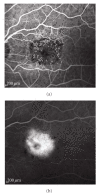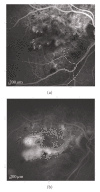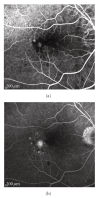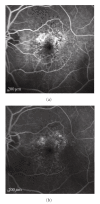Inflammatory mediators and angiogenic factors in choroidal neovascularization: pathogenetic interactions and therapeutic implications
- PMID: 20871825
- PMCID: PMC2943126
- DOI: 10.1155/2010/546826
Inflammatory mediators and angiogenic factors in choroidal neovascularization: pathogenetic interactions and therapeutic implications
Abstract
Choroidal neovascularization (CNV) is a common and severe complication in heterogeneous diseases affecting the posterior segment of the eye, the most frequent being represented by age-related macular degeneration. Although the term may suggest just a vascular pathological condition, CNV is more properly definable as an aberrant tissue invasion of endothelial and inflammatory cells, in which both angiogenesis and inflammation are involved. Experimental and clinical evidences show that vascular endothelial growth factor is a key signal in promoting angiogenesis. However, many other molecules, distinctive of the inflammatory response, act as neovascular activators in CNV. These include fibroblast growth factor, transforming growth factor, tumor necrosis factor, interleukins, and complement. This paper reviews the role of inflammatory mediators and angiogenic factors in the development of CNV, proposing pathogenetic assumptions of mutual interaction. As an extension of this concept, new therapeutic approaches geared to have an effect on both the vascular and the extravascular components of CNV are discussed.
Figures




References
-
- Green WR, Wilson DJ. Choroidal neovascularization. Ophthalmology. 1986;93(9):1169–1176. - PubMed
-
- Klein R, Peto T, Bird A, Vannewkirk MR. The epidemiology of age-related macular degeneration. American Journal of Ophthalmology. 2004;137(3):486–495. - PubMed
-
- Bressler NM. Photodynamic therapy of subfoveal choroidal neovascularization in age- related macular degeneration with verteporfin: one-year results of 2 randomized clinical trials—TAP report 1. Archives of Ophthalmology. 1999;117(10):1329–1345. - PubMed
-
- Arnold J, Barbezetto I, Birngruber R, et al. Verteporfin therapy of subfoveal choroidal neovascularization in age-related macular degeneration: two-year results of a randomized clinical trial including lesions with occult with no classic choroidal neovascularization—verteporfin in photodynamic therapy report 2. American Journal of Ophthalmology. 2001;131(5):541–560. - PubMed
-
- Bressler NM. Guidelines for using verteporfin (Visudyne) in photodynamic therapy for choroidal neovascularization due to age-related macular degeneration and other causes: update. Retina. 2005;25(2):119–134. - PubMed
Publication types
MeSH terms
Substances
LinkOut - more resources
Full Text Sources
Research Materials

